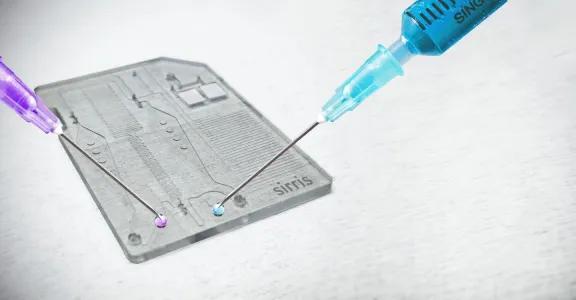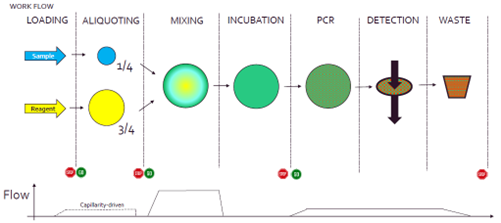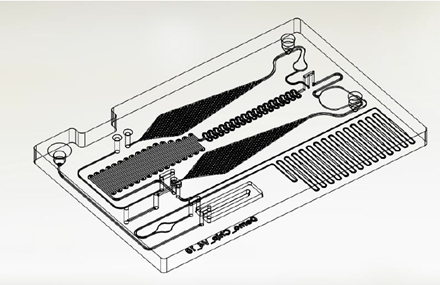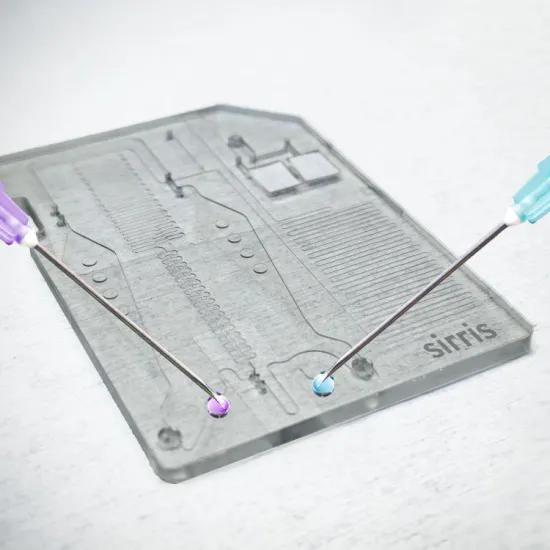Microfluidics in industry
Microfluidics - the manipulation of fluids at micro-scale - offer considerable advantages, such as a significant reduction in the volumes of samples, reagents and waste. Unique chemical and physical functions, derived from this scale, open the way to innovative applications. Designing a microfluidic component involves several key design stages, which we outline in this second article on microfluidics in industry.
Microfluidics make it possible to perform a large number of complex functions, while reducing costs and experimentation time, and ensuring precise control of the conditions under which they are implemented. Microfluidics offer great robustness, high potential for automation and remarkable ease of use. Its applications are varied, from rapid diagnostic medical devices to the creation of organs-on-a-chip, not forgetting dedicated kits for quality control in the field or any type of sample preparation (as we’ve already discussed in our previous article).
Designing a microfluidic component involves several key design stages, which we outline below.
Key stages in the design of microfluidic components
1. Defining the workflow
Start by drawing up a theoretical workflow, breaking down each stage of the targeted process. Using an existing macroscopic protocol (carried out at lab scale according to standard operations) can be a good starting point.
2. Identifying the elementary functions
Break down the workflow into elementary functions, such as sample and reagent loading, dosing, mixing, heating, filtration, detection. For each function, specify the physical parameters (temperature, flow, time, pressure) and volumetric parameters (dosage of analytes and reagents, degree of dilution). All these steps will be carried out in a spirit of miniaturisation; the aim is always to minimise resources and optimise yields, while keeping an eye on sensitivity.
3. Building the microfluidic circuit
Use a similar approach to designing complex electronic circuits, starting with a library of elementary microfluidic components. This includes inputs/outputs, reaction chambers, fluidic resistors, capillary pumps, valves of all types and vents. Specific micro-scale phenomena such as wettability, contact angles, capillary pressure and laminar flow will also be exploited to the advantage. Simulations (from simple basic equations to more complex CFD models) can be envisaged at this stage.
4. From sketch to concept
Create an initial concept for an integrated physical component - the microfluidic chip.
At this stage, it is also important to consider the auxiliary elements to be provided around the microfluidic chip. These are what will ensure its packaging and the implementation of the complete protocol. These components are generally part of the readout platform associated with the microfluidic chip: pumps, heating elements, flow controller, sensors, analysis system (optical, fluorescence, electro-chemical, ...), data management and communication..
5. 3D design
Transform the concept into an initial design of the microfluidic chip. At this stage, it is crucial to consider the future manufacturing constraints of the chip, including the assembly strategy, integration of any third-party components (membranes, reagents) and sealing. These constraints are themselves linked to the material chosen and the production cost/volume targets.
A complete design of the microfluidic chip is then obtained in the form of a 3D computer-aided design (CAD). The prototyping, fine-tuning and optimisation stages can then begin (we will get back to this in a future article).
Do you have a process in mind that you would like to (re)design to a microfluidic scale? Knowledge and production facilities are available here in Belgium, to develop and produce these products locally. We would be happy to help you get started with your idea.
Project funding
VLAIO COOCK Medical diagnostics goes micro and smart, HBC.2021.0560






